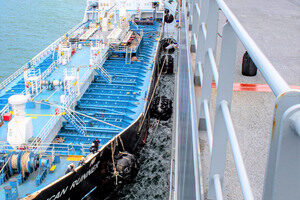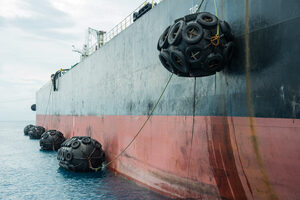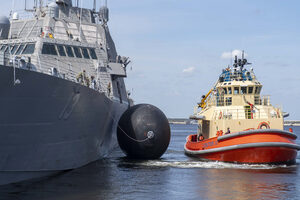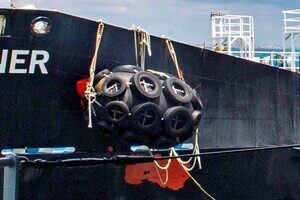Ocean Guard™ pneumatic fenders are built for demanding marine environments where reliable energy absorption and hull protection are critical. These floating pneumatic rubber fenders use compressed air to create a cushion between vessels or between a vessel and a dock, helping to prevent damage during berthing and mooring operations. Marine Fenders International supplies these pneumatic systems to ports, offshore platforms, and naval installations that require consistent performance and durability. In berthing situations involving vessels with unusual hull geometries, such as submarines, hydropneumatic fenders may also be applied alongside pneumatic systems for underwater positioning.
Pneumatic Fenders
Ocean Guard™ pneumatic rubber fenders provide an optimal solution for both permanent and semi-permanent port installations as well as offshore ship-to-ship transfers. Available in a wide range of sizes, they come in standard and high-pressure variants. Smaller fenders are designed with a sling-type configuration for easy handling and deployment, while larger fenders often include a chain–tire net system for enhanced durability and protection.
How Pneumatic Fenders Work
Ocean Guard™ pneumatic fenders operate using an internal pressure system that compresses air during contact with a vessel, absorbing kinetic energy and reducing the force transmitted to both structures. This makes them suitable for ship-to-ship transfers, LNG terminals, and emergency docking scenarios.
Pneumatic fenders are designed with a single air chamber that acts like a large cushion. When a vessel makes contact, the fender compresses and the air inside gets pressurized, which creates the cushioning effect to absorb the impact energy. Then, as soon as the compressive force is removed, the pressurized air pushes the fender back to its original shape relatively quickly.
This single-cell design is actually one of the key advantages of pneumatic fenders for offshore ship-to-ship operations.
For specific underwater berthing needs, hydropneumatic fenders are often used in conjunction with surface-level pneumatic fenders to maintain protection below the waterline. This feature is critical for submarines.
Hydropneumatic Fenders
For vessels such as submarines that require fender protection below the waterline, Ocean Guard™ hydro-pneumatic fenders are specially engineered to meet these needs. These fenders feature a partially water-filled body that is pressurized with air and ballasted to maintain a vertical position. By adjusting the water-to-air ratio and inflation pressure, the fender’s draft and performance can be precisely tailored to vessel requirements, ensuring optimal underwater fendering.
Difference Between Pneumatic and Hydro-Pneumatic Fenders
Pneumatic rubber fenders are fully air-filled and float on the water’s surface, making them ideal for ports, terminals, and ship-to-ship transfers. They are versatile, easy to handle, and can be deflated for storage or transport.
Hydro-pneumatic fenders, on the other hand, are partially water-filled and ballasted to stay upright, providing protection below the waterline. They are used for submarines, fast ferries, and semi-submersible rigs where underwater cushioning is essential.
In short, pneumatic fenders handle general berthing above the waterline, while hydro-pneumatic fenders are specialized for underwater hull protection.
Construction and Material Features
Each floating pneumatic rubber fender is constructed with layers of high-strength tire-cord material encased in a thick rubber skin. This configuration provides structural stability while resisting abrasion and environmental wear. Standard components include end flanges with inflation and deflation valves, safety pressure relief valves, and optional chain and tire nets or rope nets, depending on the application. Ocean Guard™ pneumatic rubber fenders are available in a range of diameters and lengths to meet port and vessel requirements, with customized options available upon request.
Advantages of the Ocean Guard™ Pneumatic Series
- High energy absorption with low reaction force, reducing stress on vessels and docks.
- Buoyant, corrosion-resistant, and easy to install.
- Deflatable for transport or storage and re-inflatable on-site.
- Suitable for both permanent and temporary deployments, including fleet reconfiguration or ship repairs.
Accessories and Support Equipment
We provide a full range of accessories, including mooring chains, shackles, towing rings, quick-release hooks, and inflation kits. As part of our floating fender solutions, we also offer:
- Ocean Guard™ Netless Foam-Filled Fenders
- Ocean Cushion™ Foam-Filled Fenders with chain and tire nets
These alternatives can complement marine fendering systems, such as pneumatic or hydro-pneumatic fenders in marine construction or port maintenance projects.
Standards and Performance Testing
Ocean Guard™ pneumatic rubber fenders are tested according to U.S. Navy, Coast Guard, and ISO 17357-1:2014 guidelines. Third-party testing and certification can be provided based on project specifications.
From Surface to Submarine—We’ve Got You Covered
Looking for reliable fendering solutions? Ocean Guard™ pneumatic and hydro-pneumatic fenders are made to deliver dependable protection for vessels of every size and type. Whether you need versatile pneumatic rubber fenders for port operations or specialized underwater systems for submarines and offshore rigs, Marine Fenders International has you covered. Contact us today to discuss your project requirements and find the right fender system for your application.




